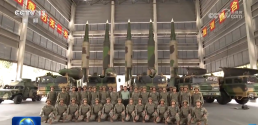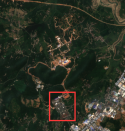You are using an out of date browser. It may not display this or other websites correctly.
You should upgrade or use an alternative browser.
You should upgrade or use an alternative browser.
China IRBM/SRBM (and non-ICBM/SLBM) thread
- Thread starter Blitzo
- Start date
20 launchers per df26 brigade is standard?
The photo does only show 17 launchers.
I thought it was 18 launchers per DF-26 Brigade.
Should be 24 launchers or 36 launchers given that every brigade has 6 launching battalions.20 launchers per df26 brigade is standard?
Because in fact this screenshot can provide a hint how they operate. The vehicle on the left should be comm vehicle, which commands and transmit nuclear code and target data. It comes with 5 launchers, by showing Xi that one comm vehicle can support 5 or maybe more launchers. Each battalion should have 1 + comm vehicle, 2+ personnel trucks.

On sentinel satellite, it shows this brigade is having huge expansion with so many independent shelters and launch pad connected closely to its garrison, so far a unique for every DF-26 brigade. The red box was originally the garrison of 611 BGD and the rest is all expanding shelters, launch pads and garages.
Bring in mind that both evidence hints that this brigade could be an nuclear exclusive brigade.
1. 611 BGD (Former 807th BGD) starts with DF-3A, then DF-21A and now DF-26. Its precedent missiles are all nuclear only, and PLARF doesn't mix up conv/nuclear during upgrade. Usually nuclear-to-nuclear and conv-to-conv. It is also the reason why this brigade was initially thought to be DF-31AG because many OSINT assumes it will have the nuclear role only.
2. In this whole news report, it repeatedly quote this brigade as "strategic missile unit" not their favorite "dual use capability" or "swap unit. It strongly indicates this brigade is nuclear only or at least nuclear priority.
(3). Not evidence but my own thought: I am always skeptical of so-called "dual use" or "hot swap" capability. Not because it is impossible, but it can cause a lot of trouble in term of operations. PLARF has two dedicated units to handle nuclear warheads carefully to protect them from unauthorized use and DF-26 has about 8 brigades, meaning it is not possible for spread out nuclear warhead handling unit throughout entire China to deal with the safety issue. It is better to have a dedicated nuclear IRBM unit than enabling every IRBM into hot swappable unit.

Should be 24 launchers or 36 launchers given that every brigade has 6 launching battalions.
Because in fact this screenshot can provide a hint how they operate. The vehicle on the left should be comm vehicle, which commands and transmit nuclear code and target data. It comes with 5 launchers, by showing Xi that one comm vehicle can support 5 or maybe more launchers. Each battalion should have 1 + comm vehicle, 2+ personnel trucks.
View attachment 137509
On sentinel satellite, it shows this brigade is having huge expansion with so many independent shelters and launch pad connected closely to its garrison, so far a unique for every DF-26 brigade. The red box was originally the garrison of 611 BGD and the rest is all expanding shelters, launch pads and garages.
Bring in mind that both evidence hints that this brigade could be an nuclear exclusive brigade.
1. 611 BGD (Former 807th BGD) starts with DF-3A, then DF-21A and now DF-26. Its precedent missiles are all nuclear only, and PLARF doesn't mix up conv/nuclear during upgrade. Usually nuclear-to-nuclear and conv-to-conv. It is also the reason why this brigade was initially thought to be DF-31AG because many OSINT assumes it will have the nuclear role only.
2. In this whole news report, it repeatedly quote this brigade as "strategic missile unit" not their favorite "dual use capability" or "swap unit. It strongly indicates this brigade is nuclear only or at least nuclear priority.
(3). Not evidence but my own thought: I am always skeptical of so-called "dual use" or "hot swap" capability. Not because it is impossible, but it can cause a lot of trouble in term of operations. PLARF has two dedicated units to handle nuclear warheads carefully to protect them from unauthorized use and DF-26 has about 8 brigades, meaning it is not possible for spread out nuclear warhead handling unit throughout entire China to deal with the safety issue. It is better to have a dedicated nuclear IRBM unit than enabling every IRBM into hot swappable unit.
View attachment 137510
Previous public reporting had 12 or 18 launchers per DF-26 Brigade. That implies 6 launchers per Battalion. All the other missile battalions in the world seem to have 4 or 6 launchers, so 5 launchers for a DF-26 Brigade seems highly unlikely.
I would add that having 2 DF-26 Brigades with a dual nuclear/conventional role makes sense, given that the nuclear infrastructure already exists.
At the beginning of any conflict, the rest of China's nuclear deterrent is intact. So you might as well use those launchers as part of the initial missile salvo to overwhelm defences.
But then those 2 DF-26 units reload and move to a exclusive nuclear deterrent role, for example.
So if there are 8 Brigades x 36 launchers, that's potentially 288 missiles in an initial salvo. Plus presumably a reload.
36 launchers may be plausible for a nuclear only brigade. The rest of the brigades may indeed be at 24 missiles.
Also, df26 is large enough and with strategic enough role that it's not assured that all units would have reloads.
Though, i agree, at least some units should have reloads ready. like those meant to engage Guam.
I wouldn't be surprised if df26 inventory is now at 240+
Also, df26 is large enough and with strategic enough role that it's not assured that all units would have reloads.
Though, i agree, at least some units should have reloads ready. like those meant to engage Guam.
I wouldn't be surprised if df26 inventory is now at 240+
I wouldn't be surprised if df26 inventory is now at 240+
DF-26 production rate is dramatically high. Based on satellite image, the factory is producing at least 20 launcher per quarter. I would assume an annual production rate at 90 ~ 100 right now.So if there are 8 Brigades x 36 launchers, that's potentially 288 missiles in an initial salvo. Plus presumably a reload.
36 launchers may be plausible for a nuclear only brigade. The rest of the brigades may indeed be at 24 missiles.
Also, df26 is large enough and with strategic enough role that it's not assured that all units would have reloads.
Though, i agree, at least some units should have reloads ready. like those meant to engage Guam.
I wouldn't be surprised if df26 inventory is now at 240+
DOD reporting on the DF-26 was about "250 launchers with 500 missiles by October 2023"
DF-26 production rate is dramatically high. Based on satellite image, the factory is producing at least 20 launcher per quarter. I would assume an annual production rate at 90 ~ 100 right now.
Spread across 8 brigades, my guess is that 250-300 DF-26 launchers is enough.
180 missiles in a salvo (5 Brigades?) should be more than enough to overwhelm any THAAD or US Navy SM3 ballistic missile defence.
So my guess is that they have slowed or stopped DF-26 launcher production.
---
However, continuing missile production at 80-100? per year for reloads make sense.
Guam can be repaired and reinforced. And more carriers could be redeployed to the Western Pacific.
If you want to cover these contingencies, then 500 DF-26 missiles isn't enough.
My guess is that they would need another 500-1000
So my guess is that by the 2027 target date - they'll have about 1000 DF-26 missiles in total.
Then perhaps by that point, they might have switched to DF-27 production?
---
Note that this notional DF-26 missile buildup will cost far, far less than the the value of potential targets on Guam or carriers.
EDIT
Actually, annual DF-26 missile production would be double the number of launchers, given 2 missiles per launcher.
So that would mean closer to 1500 DF-26 missiles in total by 2027 in the scenario above
Last edited:
Following on from the above, it would mean using Guam as an airbase for any aircraft (including NGAD) is a non-starter
---
And I note that the CSBA had an old cost estimate of $20 Mn for a DF-26 class IRBM made in the US. Now, that is almost certainly far higher than what a DF-26 costs in China.
But let's go with that figure to be charitable to the US.
1500 DF-26 missiles would cost $30 Bn, which is far less than the value of targets below. Then you've got the cost of the DF-26 Brigades themselves. In comparison
11 Carrier Groups @ $20+ Bn each
7 THAAD Batteries @ $1 Bn each
B-2 @ $1 Bn each
B-21 @ $0.5 Bn each
NGAD @ $0.25 Bn each
Tankers @ $0.2 Bn each
So we're looking at an order of magnitude (10x) in terms of cost difference here.
---
And I note that the CSBA had an old cost estimate of $20 Mn for a DF-26 class IRBM made in the US. Now, that is almost certainly far higher than what a DF-26 costs in China.
But let's go with that figure to be charitable to the US.
1500 DF-26 missiles would cost $30 Bn, which is far less than the value of targets below. Then you've got the cost of the DF-26 Brigades themselves. In comparison
11 Carrier Groups @ $20+ Bn each
7 THAAD Batteries @ $1 Bn each
B-2 @ $1 Bn each
B-21 @ $0.5 Bn each
NGAD @ $0.25 Bn each
Tankers @ $0.2 Bn each
So we're looking at an order of magnitude (10x) in terms of cost difference here.
antiterror13
Brigadier
Following on from the above, it would mean using Guam as an airbase for any aircraft (including NGAD) is a non-starter
---
And I note that the CSBA had an old cost estimate of $20 Mn for a DF-26 class IRBM made in the US. Now, that is almost certainly far higher than what a DF-26 costs in China.
But let's go with that figure to be charitable to the US.
1500 DF-26 missiles would cost $30 Bn, which is far less than the value of targets below. Then you've got the cost of the DF-26 Brigades themselves. In comparison
11 Carrier Groups @ $20+ Bn each
7 THAAD Batteries @ $1 Bn each
B-2 @ $1 Bn each
B-21 @ $0.5 Bn each
NGAD @ $0.25 Bn each
Tankers @ $0.2 Bn each
So we're looking at an order of magnitude (10x) in terms of cost difference here.
If US can make $20M, likely China can make it for $5M to max $10M, so 1,500 DF-26 wouldn't cost too much, about $7.5B to $15B .... nothing really, considering the huge impact of strategic calculation
